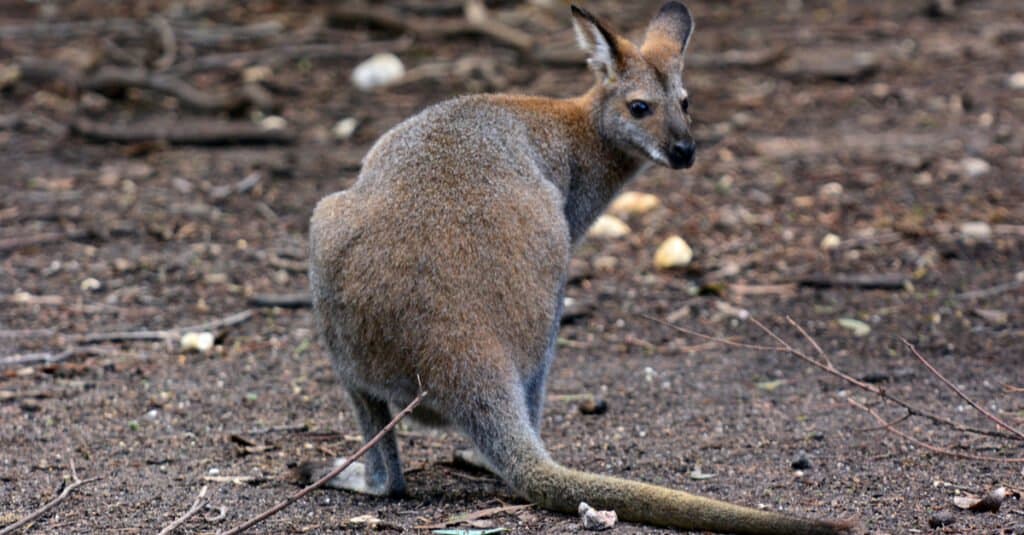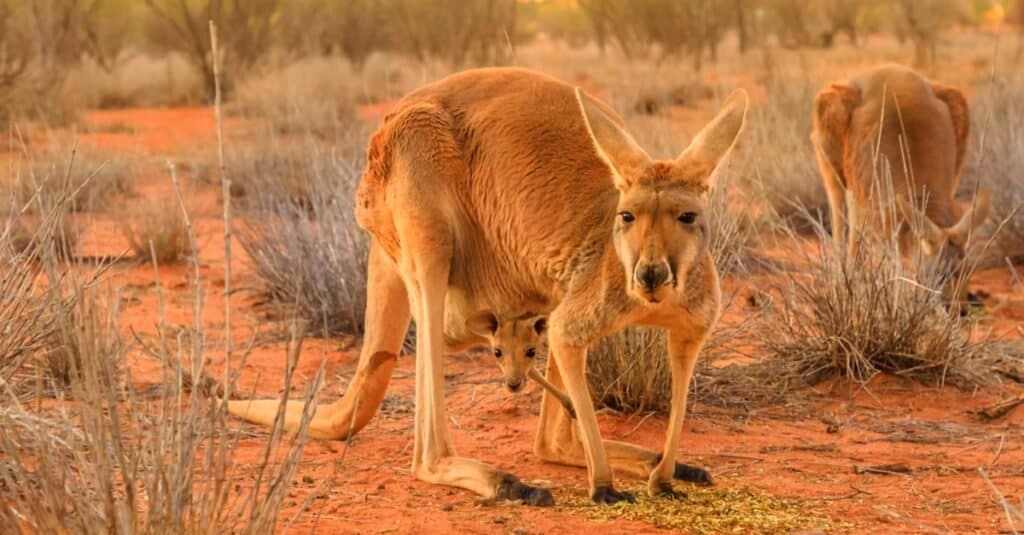When most people think of Australia, the first animal that comes to mind is the kangaroo. A member of the marsupial family Macropodidae, there exists four extant species of kangaroo that are considered “true” kangaroos. That said, there are nearly 65 species in the kangaroo clan, including wallabies, tree-kangaroos, wallaroos, quokkas, and pademelons. You can identify most kangaroos based upon their large hind legs, big feet, and long tails. Native to both Australia and New Guinea, the kangaroo is an iconic symbol of both countries. As a matter of fact, there are nearly double the number of kangaroos in Australia as people. Kangaroos have historically served as an important source of meat, and appear frequently in both ancient legends and modern media sources. Despite their well-known position in the public consciousness, few people can answer the question, “what do kangaroos eat?”
In this article, we’ll attempt to dispel any myths surrounding what kangaroos eat. We’ll start off with a brief overview of the foods that most kangaroos like to eat. Then, we’ll move on to a conversation about how kangaroos forage for food. Next, we’ll compare what kangaroos eat in the wild versus what they eat in captivity. Finally, we’ll end with a discussion about what baby kangaroos eat. So, let’s hop along and answer the question, “what do kangaroos eat?”
What Do Kangaroos Like to Eat?

Kangaroos are strict herbivores, meaning that they rely on plant matter to survive. That being said, different species of kangaroos eat different diets. Some species are predominantly grazing animals that subsist mostly on grasses. Meanwhile, others also forage for different plants and shrubs. Additionally, smaller kangaroo species will eat other foods such as fungi. As such, it’s wrong to say that all kangaroos eat the same foods. Regional differences play a significant part in determining the dietary habits of kangaroos. On top of it all, terrestrial kangaroos eat a different diet from tree kangaroos, which are omnivorous. Unlike terrestrial kangaroos, tree kangaroos will also eat eggs and birds. However, for the purposes of this article, we’ll focus on the “true” kangaroos, which include the red kangaroo, antilopine kangaroo, eastern grey kangaroo, and western grey kangaroo. We’ve identified 6 foods that these kangaroos generally like to eat. These 6 foods include:
- Grasses
- Shrubs
- Leaves
- Moss
- Fruit
- Flowering plants
How Do Kangaroos Forage For Food?

Kangaroos possess specialized teeth to help them cut and grind grass which they replace throughout their lives.
©iStock.com/photogerson
Kangaroos possess many of the same senses as humans. As such, they rely on their vision, smell, sight, touch, and taste to find food. That said, they rely on some senses more than others while foraging. One of a kangaroo’s most important senses for finding food is its eyesight. Kangaroos have keen vision, which helps them to locate ripe leaves and seek out the most succulent patches of grass. Additionally, kangaroos also evolved a very precise sense of smell. A kangaroo can smell watering holes from miles away, along with the fauna that grows around them. This trait is essential for surviving in the outback, where food can be scarce and water even scarcer. While kangaroos possess excellent hearing, they don’t often rely on their hearing to find food. However, their hearing is essential for communication with other kangaroos and for avoiding predators.
Kangaroos are mostly active at night, dawn, and dusk when the hot sun is less of a factor. This is also when they do most of their foraging and feeding. Unlike ruminants, which possess stomachs with multiple chambers, kangaroos have single-chambered stomachs. However, like ruminants, they will occasionally regurgitate plant matter that they have previously eaten and chew it as cud. While some kangaroos, such as eastern grey kangaroos, are grazers, others like the red kangaroo are foragers. Kangaroos evolved very specific teeth to accommodate their grazing habits. They possess sharp incisors capable of shearing grass and flat molars designed for grinding grass for easier digestion. Over time their teeth are ground down by the silica in the grass. To address this issue, they grow new teeth in the back of their mouths to replace the ones that fall out.
What Do Kangaroos Eat in the Wild?

Grasses and shrubs make up the bulk of a kangaroo’s diet.
©ChameleonsEye/Shutterstock.com
In the wild, kangaroos are strict herbivores that live on native plant material and other vegetation. Eastern grey kangaroos and antilopine kangaroos are predominantly grazers and live mostly on different wild grasses. In particular, eastern grey kangaroos enjoy grazing on young green grasses. That said, they will also eat fungi and shrubbery on occasion. On the other hand, red kangaroos and western grey kangaroos are foragers. While their diet mostly consists of grasses, they frequently eat the leaves from shrubs and trees. Additionally, they may also eat parts from certain flowering plants. Generally speaking, kangaroos tend to eat more grass when the weather is hot and dry, and more leaves during and shortly after the rainy season when plants flourish.
What Do Captive Kangaroos Eat?

Many zoos choose to feed their captive kangaroos a specially formulated pellet diet designed for grazing mammals.
©Benny Marty/Shutterstock.com
Although kangaroos are common in Australia and New Guinea, they are not native anywhere else in the world. As a result, they are popular attractions in zoos across the globe. People love to watch these kangaroos hop around on their giant feet, and particularly enjoy the sight of a baby kangaroo resting in its mother’s pouch. Zoos that choose to keep kangaroos must pay special attention to a kangaroo’s diet to ensure it’s eating properly. By and large, kangaroos that live in captivity are often fed a similar diet to wild kangaroos. That said, rather than wild grasses, captive kangaroos are often fed hay or alfalfa. Many zoos also feed their kangaroos a pellet formula specially formulated for grazing animals. Some zoos will supplement their kangaroos’ diet with fruits such as apples and bananas, as well as certain vegetables. Common options include carrots, broccoli, and greens such as dandelion and lettuce.
What Do Baby Kangaroos Eat?

At birth, baby joeys measure around the size of a jellybean and are even to weak to suckle for milk.
©iStock.com/burroblando
Like other marsupials, kangaroos give birth to live young that are born relatively prematurely. Female kangaroos only gestate their embryos for around 34 days, which means the young require extra time to develop outside of the mother’s uterus. Baby kangaroos, or joeys, measure only around 1 inch long at birth and are born hairless and completely blind. Upon birth, the helpless joey will crawl into its mother’s pouch, where it will remain for the first four to six months of its life. At first, joeys are so weak that they can’t even suckle for their mother’s milk. To accommodate this, female kangaroos will pump milk into their offspring’s open mouths. At around four to six months old, the joeys are old enough to venture out and start to eat some grasses and shrubs. By eight to ten months old, they are big enough to leave the pouch completely.
The photo featured at the top of this post is © iStock.com/Andrew Coleman
Thank you for reading! Have some feedback for us? Contact the AZ Animals editorial team.






